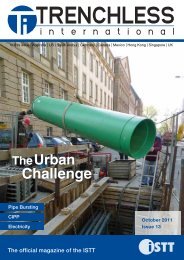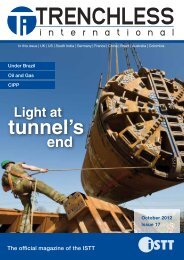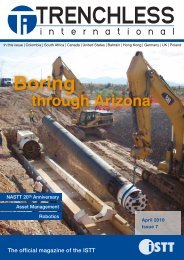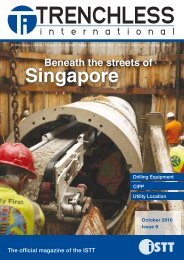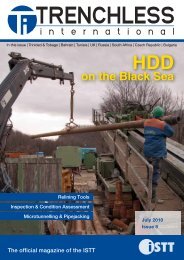North American Special - Trenchless International
North American Special - Trenchless International
North American Special - Trenchless International
You also want an ePaper? Increase the reach of your titles
YUMPU automatically turns print PDFs into web optimized ePapers that Google loves.
During the above process WP was<br />
planning for the Pine Creek HDD.<br />
Success of the HDD was contingent on<br />
obtaining adequate subsurface geotechnical<br />
information to assist in engineering<br />
the crossing; the geotechnical investigation<br />
was completed in January 2007.<br />
Construction of the Pine Creek Loop was<br />
carried out successfully, with the Pine<br />
Creek HDD slated for July 2007.<br />
Due to the protected status of the La<br />
Biche River Wildland Park, no additional<br />
ROW was being granted within the park.<br />
WP attempted to design an HDD crossing<br />
with this restriction in mind but could<br />
not achieve the desired results based on<br />
the following:<br />
• The existing AOSPL ROW configuration<br />
was designed to accommodate<br />
the previously installed trenched<br />
crossing. There were changes in horizontal<br />
direction both upstream and<br />
downstream of the crossing.<br />
• A number of adjacent pipelines within<br />
the area had to be crossed along the<br />
HDD path.<br />
• The minimum design radius of curvature,<br />
required clearance from the<br />
bottom of Pine Creek and the required<br />
entry and exit angles.<br />
To ensure Pembina would be successful<br />
in obtaining the required approvals,<br />
WP chose the final alignment to utilise<br />
only existing cleared areas for the<br />
Above: Construction on hot lines with mats.<br />
Below: Direct Horizontal Rig AA 440,000 lb.<br />
necessary ROW required by the HDD<br />
alignment. The final design involved<br />
entry and exit angles of 10 degrees.<br />
Entry angles are typically steeper in<br />
order to minimise the potential for fluid<br />
releases to surface near entry and exit<br />
but 10 degrees was essential to limit<br />
the overall length of the HDD. The depth<br />
under the creek was set at the required<br />
minimum of 15 metres as noted in the<br />
geotechnical report. The alignment and<br />
length chosen had under crossings of<br />
the Suncor and Shaw cable utilities. As<br />
access on the north side of the crossing<br />
within the Park was limited, the drill entry<br />
point was established on the south side,<br />
even though the elevation was slightly<br />
higher than the north side. The total<br />
design length was about 440 metres. As<br />
a result of the alignment of the drill and<br />
the adjacent hot lines, extensive rig mats<br />
were required to allow work to be carried<br />
out over the top of these lines as well as<br />
most other aspects of the work.<br />
Ledcor Pipelines was awarded the<br />
mainline contract for the Horizon Pipeline<br />
Project. Ledcor subsequently awarded<br />
the HDD subcontract to Direct Horizontal<br />
of Stoney Plain Alberta. Direct completed<br />
the NPS 24 La Biche River crossing with<br />
an <strong>American</strong> Auger DD440 and moved<br />
the same drill rig to the south side of Pine<br />
Creek in July 2007. The selected drill rig<br />
(pictured) can be set up to enter at a<br />
minimum of 12 degrees, steeper than the<br />
designed entry of 10 degrees. Due to this<br />
change in the vertical alignment and the<br />
deepening of the bore profile as a result<br />
of steering difficulties, the total length of<br />
the drill ended up at 494.3 metres, an<br />
increase in length of about 12 percent.<br />
Problems with fluid releases close to<br />
the rig were encountered as a result of<br />
the soft ground and the shallow depth<br />
due to the shallow entry angle. Ultimately<br />
the contractor chose to put in 40 metres<br />
of 42 inch casing and then installed 70<br />
metres of 12 inch casing to minimise the<br />
fluid releases to surface. The 12 inch<br />
casing was utilised during the pilot hole<br />
drilling to try to ensure that the pilot hole<br />
was not lost as a result of the tripping in<br />
and out of the pilot hole in the soft clay<br />
formation.<br />
In addition, the contractor requested<br />
changes to the drill path to allow for a<br />
deeper drill path to minimise fluid releases.<br />
The minimum radius for the drill was set at<br />
600 metres at any point along the drill.<br />
Due to the soft nature of the clay, steering<br />
was somewhat difficult, requiring frequent<br />
adjustments. Ultimately the contractor was<br />
successful in completing the pilot hole<br />
and the first ream.<br />
At this point the engineer was provided<br />
the as-built drill profile survey data for<br />
review. Engineering Technology Inc of<br />
Calgary (Entec) was contracted to review<br />
the survey data and provide information<br />
regarding the drilled radius of the crossing.<br />
Entec used the industry accepted<br />
‘dogleg’ method to calculate the minimum<br />
radius along the drill path. The smallest<br />
radius found was 270 metres and another<br />
16 points where the radius was below the<br />
Above: View of product pipe.<br />
Below: Successful pipe pull.<br />
minimum recommended radius of 600<br />
metres.<br />
The 270 metre radius was calculated<br />
to be close to failure under installation<br />
stresses and beyond failure under operating<br />
stresses. Due to the large discrepancy<br />
between the pilot hole minimum radius of<br />
270 metre and the recommended minimum<br />
radius of 600 metres a more refined<br />
analysis of the crossing would be required<br />
to accurately determine if the current pilot<br />
hole drill path was in fact acceptable.<br />
There are a number of methods available<br />
for calculating the combined stress<br />
within an HDD drill path. The Tresca, Von<br />
Mises and limit states approaches are<br />
all recognised within the CSA Z662 and<br />
offer varying degrees of conservatism.<br />
Regardless of the method chosen stress<br />
is analysed for a pipeline within the HDD<br />
path for the maximum operational conditions.<br />
The presence of applied loads in more<br />
than one direction results in a much more<br />
complex state of stress than for applied<br />
loads in only one direction (uniaxial). The<br />
predominant stresses in pipelines are typically<br />
biaxial, with internal pressure acting<br />
in the circumferential (hoop) direction and<br />
thermal loads and beam bending acting<br />
in the longitudinal direction. The yielding<br />
of the steel under these conditions is<br />
considerably more complex, and there<br />
are two widely accepted approaches for<br />
determining the combination of stress in<br />
various directions that result in yielding<br />
of ductile material (such as steel); the two<br />
approaches are the Tresca theory and the<br />
von Mises theory (Please refer to the conference<br />
paper for further information).<br />
The combined stress as per CSA Z662<br />
April 2009 - <strong>Trenchless</strong> <strong>International</strong><br />
north america<br />
north america<br />
April 2009 - <strong>Trenchless</strong> <strong>International</strong><br />
54<br />
55






